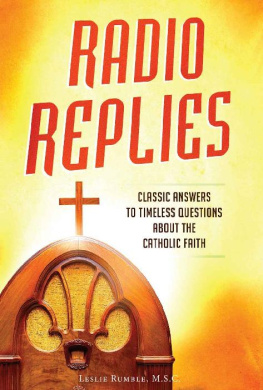Fr. Leslie Rumble - A Brief Life of Christ
Here you can read online Fr. Leslie Rumble - A Brief Life of Christ full text of the book (entire story) in english for free. Download pdf and epub, get meaning, cover and reviews about this ebook. year: 2015, publisher: TAN Books, genre: Detective and thriller. Description of the work, (preface) as well as reviews are available. Best literature library LitArk.com created for fans of good reading and offers a wide selection of genres:
Romance novel
Science fiction
Adventure
Detective
Science
History
Home and family
Prose
Art
Politics
Computer
Non-fiction
Religion
Business
Children
Humor
Choose a favorite category and find really read worthwhile books. Enjoy immersion in the world of imagination, feel the emotions of the characters or learn something new for yourself, make an fascinating discovery.

- Book:A Brief Life of Christ
- Author:
- Publisher:TAN Books
- Genre:
- Year:2015
- Rating:3 / 5
- Favourites:Add to favourites
- Your mark:
- 60
- 1
- 2
- 3
- 4
- 5
A Brief Life of Christ: summary, description and annotation
We offer to read an annotation, description, summary or preface (depends on what the author of the book "A Brief Life of Christ" wrote himself). If you haven't found the necessary information about the book — write in the comments, we will try to find it.
A Brief Life of Christ — read online for free the complete book (whole text) full work
Below is the text of the book, divided by pages. System saving the place of the last page read, allows you to conveniently read the book "A Brief Life of Christ" online for free, without having to search again every time where you left off. Put a bookmark, and you can go to the page where you finished reading at any time.
Font size:
Interval:
Bookmark:
A Brief Life of
Christ
Rev. Dr. L. Rumble,
M.S.C.
Imprimatur: |  | Joannes Gregorius Murray |
Archiepiscopus Sancti Pauli | ||
Paulopoli die 17a maii 1956 |
Copyright 1974 by TAN Books.
Originally published by Fathers Rumble and Carty, Radio Replies Press, Inc., St. Paul, Minn., U.S.A.
Retypeset and republished in 2010 by TAN Books.
Complete and unabridged.
TAN Books
Charlotte, North Carolina
www.TANBooks.com
2012

INTRODUCTORY
Jesus Christ, whose first name means Saviour and whose second name means Anointed or Consecrated, was born, not when our calendar says He was, but about six years earlier.
Our present calendar was drawn up by Dionysius Exiguus in the 6th century A.D., and we now know that he was some six years out in his calculations.
The mistake of Dionysius, of course, has nothing to do with the historical fact of Our Lords birth. It only means that what we thought of as, say, 1950 A.D., was really more like 1956 A.D.
For the actual facts about Christ we are mainly dependent upon the four gospels. These however have been subjected to an exhaustive examination such as no other documents have had to undergo, and their authenticity as documents is beyond reasonable dispute.
The authors were in a position to write thoroughly good history. Were the documents concerned with an ordinary man, and did they deal with none but ordinary utterances and events, no one would dream of doubting their reliability.
It is what they contain that unbelievers declare incredible; and that, only when the gospels mention things beyond the range of normal human experience. When they deal with all that belongs to the ordinary and natural sphere, research has shown them to be accuracy itself whether in regard to persons, places or things.
It is sheer prejudice against any religious revelation by God, and above all against the possibility of confirming such a revelation by miracles, which makes men regard the evangelists as either having taken leave of their senses, or else as having been positively dishonest, whenever they recorded as actual fact anything savoring of the supernatural or miraculous. These unbelievers have not approached the gospels with open minds, despite their boasting that they have done precisely that.
There is no room in this little book to discuss their position. Nor is there need to do so. It will be enough to set out briefly the life of Christ as depicted in the gospels, necessarily omitting much for purposes of condensation, but taking care in all that is said to remain strictly faithful to the basic facts recorded in our unimpeachable sources.
THE SETTING
Jesus was born in the little town of Bethlehem, in Palestine, a small country only 150 miles long and from 50 to 80 miles wide, on the extreme East coast of the Mediterranean Sea. Palestine, therefore, is only about half the size of the State of Indiana, in America.
It takes its name from the Philistines, a pagan people who settled on the coast of this country at about the same time as the Hebrews or People of Israel conquered the mountain land some 1300 years before the birth of Jesus.
At the time of His birth the People of Israel, called Jews after the main tribe of Juda, had themselves been conquered by the Romans. True, they had a king named Herod the Great; but he had been appointed by Rome and was subject to the Roman Emperor.
Herod the great died in 4 B.C., about two years after Jesus was born.
Then the Romans divided Palestine into four parts. One of Herods sons, Archelaus, was to rule over Judea and Samaria, in the South; another, Philip, was given Iturea in the North; a third son, Herod Antipas, ruled over Galilee in the Middle-West and Perea in the South-East; whilst Rome directly ruled over Decapolis, an area East of the Jordon.
When Jesus was a little boy of about twelve, Archelaus was deposed by the Romans for being too despotic, and Roman Governors were appointed instead, to rule over Judea and Samaria.
One of these Governors was Pontius Pilate, who was in charge from 26 A.D. until 36 A.D.
It was under Pontius Pilate that Jesus was to die.
The Jews were a religious people. All the nations around them were pagans, but they worshipped the one true God, carefully observing the laws given to them by Moses. The main centre of their worship was the great Temple in Jerusalem, the capital of Judea. In the different villages they had synagogues or meeting-places for prayer and the reading of the Scriptures; but sacrifice could be offered to God only in the one Temple at Jerusalem. Because of this, on great religious festivals thousands of Jews would flock there from all parts of Palestine, and even from other countries overseas.
Among the Jews there were several parties, two of which are very often mentioned in the gospels, the Pharisees and the Sadducees.
The Pharisees, or Separated Ones, claimed to observe the Mosaic Law perfectly, much better than the rest of the Jews. But whilst they were most exact outwardly, most of them were proud and very hard and uncharitable towards others. Not all were like that, of course. There were some really good, sincere and holy men among them.
The Sadducees, or Descendants of Sadoc (Sadoc means Justice), belonged to the richer classes. They were very worldly and, although they did not deny that the Law of Moses should be observed, they were not very strict about it. Many of them denied the existence of a future life and other orthodox teachings. Most of the Jewish priests belonged to these Sadducees.
The Jews, generally, were not very contented under the rule of the Romans; and as their religion taught them to look forwards towards a Messiah or divinely-sent Saviour, most of them hoped He would be a great political and military leader who would defeat the Romans and make themselves the greatest nation in the world.
Such was the setting in Palestine when Jesus was born in Bethlehem.
BIRTH OF JESUS
Most biographies of people begin with an account of their birth, and, perhaps, of their family history. But whilst the life of Jesus as born into this world began in Bethlehem, it cannot be said that He personally began to exist only then. Before the Incarnation, He had always lived in Heaven; and it would be impossible to get back to the beginning of His life there, for He is the Eternal Son of God. To be eternal is to be without a beginning at all! But that aspect of His life would take us beyond recorded history as the world knows it.
St. Johns gospel, however, tells us that one day He made this world, and indeed the whole universe, ages before He came into it Himself; and when He did come into our midst as Man to redeem and save us, He told us that He still belonged to Heaven; and always He spoke of it as only one could speak who is perfectly familiar with everything there. We shall meet with many such utterances in the course of His life on earth within the framework of history, the aspect of His life with which this booklet is concerned.
We have already said that Herod the Great died in the year 4 B.C., according to our present calendar. Now about three years before that, there was living at Nazareth, a little town in the hills of Galilee, a young Jewish girl named Mary. In the same town there dwelt a carpenter named Joseph to whom she was betrothed, and to whom she was soon to bind herself in the final marriage ceremonies. Both Mary and Joseph belonged to the tribe of Juda and were descendants of King David, although they were in poor circumstances, as were so many others of Davids line.
Next pageFont size:
Interval:
Bookmark:
Similar books «A Brief Life of Christ»
Look at similar books to A Brief Life of Christ. We have selected literature similar in name and meaning in the hope of providing readers with more options to find new, interesting, not yet read works.
Discussion, reviews of the book A Brief Life of Christ and just readers' own opinions. Leave your comments, write what you think about the work, its meaning or the main characters. Specify what exactly you liked and what you didn't like, and why you think so.









